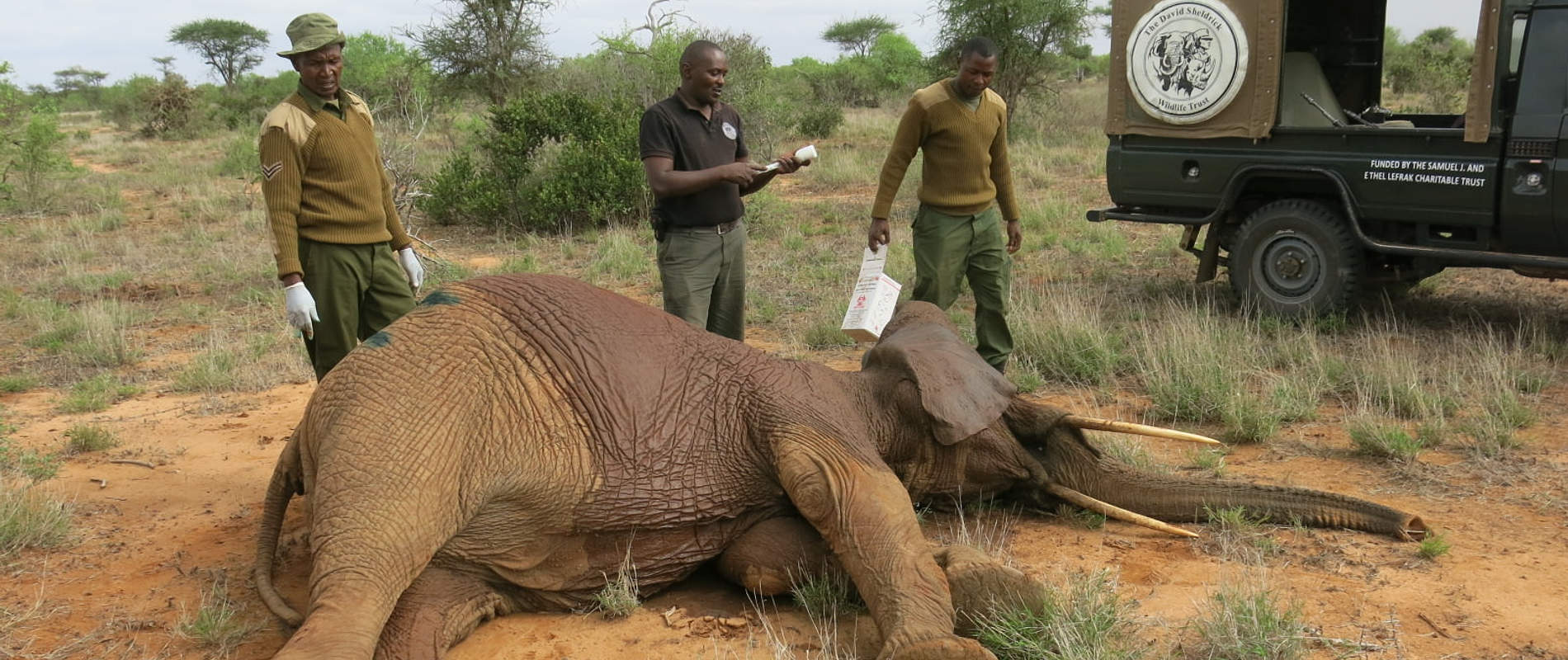MONTHLY REPORT - VETERINARY CLINICAL INTERVENTIONS FOR THE SOUTHERN CONSERVATION AREA (SCA) – October 2015 Report by; Dr
MONTHLY REPORT - VETERINARY CLINICAL INTERVENTIONS FOR THE SOUTHERN CONSERVATION AREA (SCA) – October 2015
Report by; Dr. Michael Njoroge
INTRODUCTION
The SCA mobile unit during this month was faced with a number of cases within Amboseli and Tsavo ecosystems. There has been a gradual increase in the number of cases probably due to the dry weather season.
CASE#1 TREATMENT OF AN ELEPHANT WITH AN ARROW INJURY
Date: 8th October 2015
Species: Elephant
Sex: Female
Age: Adult (20 – 25 years)
Location: Satao, Tsavo East National Park
History
The DSWT pilot reported to have spotted a male elephant with a suspected arrow head injury to the left hind limb. The veterinary team located and assessed the elephant from the helicopter before deciding to treat it.
Immobilization, examination and treatment
The elephant was immobilised with 18mg Etorphine in a 3 ml dan - inject dart using the Dan Inject system and was relatively easy from a helicopter. The elephant went down on lateral recumbence after 8 minutes. The trunk was maintained patent using a piece of stick placed across the nostril entrances. The temperature was high hence plenty of water was doused on the elephant to keep the body temperature low. The ears were used as blindfold.
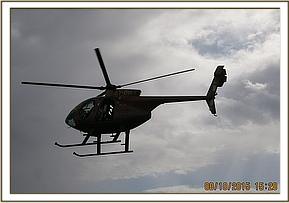

On physical examination the elephant had a penetrating wound to the left hind limb. The wound was relatively fresh and likely to have been caused by an arrow head. The wound was thoroughly cleaned using water and Hydrogen Peroxide before it was lavaged using tincture of Iodine. Topical antibiotic cream and green clay was then applied into the wound to facilitate healing and prevent infection. The elephant was then injected with 100 ml Betamox L.A and 50 ml Dexamethasone at different sites intramuscularly. The entire operation lasted about 20 minutes.
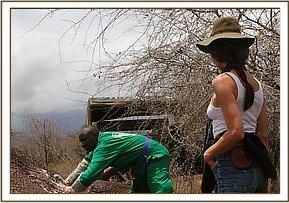

Reversal
The anaesthetic was reversed using 60mgs Diprenorphine Hydrochloride into the ear vein. The elephant took 4.5 minutes to get up and move away from the site.
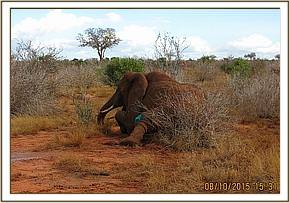

Prognosis
Good
CASE#2 TREATMENT OF AN ELEPHANT WITH AN ARROW INJURY
Date: 8th October 2015
Species: Elephant
Sex: Male
Age: Adult (30 – 40 years)
Location: Rukinga
History
The rangers at Rukinga reported an injured elephant with a suspected arrow head injury to the right flank. The elephant was darted from a helicopter for examination and treatment.
Immobilization, examination and treatment
The elephant was immobilised with 18mg Etorphine in a 3 ml dan - inject dart using the Dan Inject system and was relatively easy from a helicopter despite the thick vegetation. The elephant went down on lateral recumbence after 7 minutes. The trunk was maintained patent using a piece of stick placed across the nostril entrances. The temperature was high hence plenty of water was doused on the elephant to keep the body temperatures low. The ears were used as blindfold.
On physical examination the elephant had an approximately 5 inch deep wound (3-4 weeks old) to the right flank region. The wound was septic and had necrotic tissue with lots of pus. The wound was caused by an arrow which was retrieved from the wound. The dead tissue was debrided and removed.
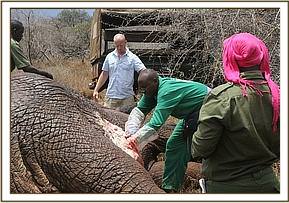

The wound was then thoroughly cleaned using clean water and Hydrogen Peroxide and then lavaged using tincture of Iodine. An opening on the ventral side of the wound was made for easy drainage to prevent further infection. Topical antibiotic cream and green clay was then applied into the wound to facilitate healing and avoid infection. The elephant was also injected with 100ml Betamox, 1200 mg Clindamycin (Dalacin C) and 100ml Dexamethasone at different sites intramuscularly. The entire operation lasted about 20 minutes.
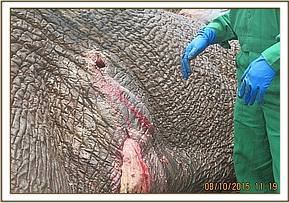

Reversal
To reverse the anaesthetic Diprenorphine Hydrochloride (60mgs) was injected into the ear vein. It took about 5 minutes to be fully awake from anaesthesia.
Prognosis
Good
CASE#3 RESPONDING TO A TRAPPED ELAND CASE
Date: 9th October 2015
Species: Eland
Sex: Female
Age: Sub adult
Location: Amboseli
History
An eland was reported trapped in an electric hotel fence in the Amboseli ecosystem. The veterinary team attended to the case immediately.
Examination
The eland was found still trapped on the electric fence and had already succumbed to the effects of electrick shock.
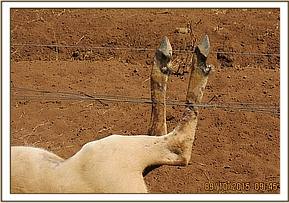

Cause of death
Effects of electric shock
CASE#4 TREATMENT OF A BLIND GIRAFFE
Date: 10th October 2015
Species: Giraffe
Sex: Female
Age: Adult
Location: Olorika, Chyulu Ecosystem
History
A female giraffe was reported to be blind within the Chyulu area. The KWS Loitokitok station reported to the veterinary team who attended to the case immediately for examination and treatment.
Immobilization, examination and treatment
The giraffe was darted using 15 mg Etorphine and 30 mg Azerperone from foot because of the rocky terrain. The giraffe was brought down using ropes once the narcotics had taken effect.
On physical examination the giraffe had suffered from an eye infection leading to total loss of the left eye. The right eye was treated using a combination of 3ml penicillin streptomycin and 3ml Dexamethasone HCL. Antibiotic cream was also applied.


Reversal
The anesthetic was reversed using 45 mg Diprenorphine Hcl into the jugular vein.
Prognosis
Guarded
CASE#5 POSTMORTEM REPORT OF AN ELEPHANT
Date of Death: 13th October 2015
Date of Postmortem: 14th October 2015
Species: Elephant
Sex: Female
Age: Adult (40 years old)
Location: Amboseli
History
The sudden collapse and death of an elephant at the Amboseli National Park was reported to the SCA mobile veterinary team. This case was reported as a seriously sick elephant which had gone recumbent and died suddenly. A postmortem was carried out and the following was observed.
General and physical examination of the carcass
On general examination, the animal was in poor body condition and was on the right lateral side. She had a small penetrating wound (5 cm deep) caudal to the right eye which was full of pus. On probing the wound, no object was retrieved.

Examination of the opened carcass
On opening the carcass, all body organs looked normal suggesting the condition was not chronic.
The G.I.T system had very little ingesta showing that the elephant had been off feed for a considerable period. The gut had plenty of bile suggesting starvation.
Samples collected
-Blood from the ear vein
-Blood smear
-Feacal sample from the g.i.t
Differential diagnosis
Bacterial/viral infection
CASE#6 TREATMENT OF INJURED ELEPHANT
Date: 16th October 2015
Species: Elephant
Sex: Male
Age: Adult (35 – 40 years)
Location: Tsavo East National Park
History
This case was seen whilst searching for another reported injured elephant. It had a fairly large swelling on the right fore limb. With an already prepared dart, this elephant was immobilized and attended to.
Immobilization, examination and treatment
The elephant was immobilised with 18mg Etorphine in a 3 ml dan - inject dart using the Dan Inject system from a vehicle. After 10 minutes, the bull went recumbent but on the wrong side and had to be rolled over to expose the wounded limb for examination and treatment. The trunk was maintained patent using a piece of stick placed across the nostril entrances. The temperature was high hence plenty of water was doused on the elephant to keep the body temperatures low. The ears were used as blindfold.
On physical examination the elephant had a large swelling on the right fore limb. However no physical injury could be seen and it was suspected that the swelling could have been caused by trauma. The elephant was then injected with 100 ml Betamox L.A and 100ml Dexamethasone at different sites intramuscularly. The entire operation lasted about 20 minutes.


Reversal
The anaesthetic was reversed using 60mg Diprenorphine Hydrochloride into the ear vein. It took 5 minutes to get up and walk away from the site.
Prognosis
Good.
CASE#7.TREATMENT OF INJURED ELEPHANT
Date: 16th October 2015
Species: African elephant
Sex: Female
Age: 20-25 yrs Adult
Location: Tsavo East
History
On the 16/10/2015 while planning to attend to another case, the Veterinary Team received an urgent report regarding an injured elephant in an accident. The motor vehicle KBQ 681D Toyota Land cruiser was involved in the accident between sign post 137 and Aruba Lodge in Tsavo East earlier in the morning. The team immediately attended to the case for clinical intervention.
The team found the injured elephant in a small herd of elephants in a small thicket. She could be seen limping from a distance and had a swollen hock. A decision was made to immobilize, examine and treat the elephant.
Immobilization, examination and treatment
The elephant was chemically restrained by use of 16mgs Etorphine in a 3ml Dan inject dart through the Dan inject darting system from a vehicle. She appeared agitated initially but finally calmed as the drugs took effect. She was fully narcotized after 7 minutes assuming left lateral recumbency.


Close examination revealed a fresh injury to the right hind limb. On palpation, no crepitation could be felt. However the hock joint felt weak and swollen indicating a definite injury to the joint. A muscle/ligament tear or laxation of the hock joint was suspected. To prevent scepsis and inflammation, 100ml Betamox, 1200 mg Clindamycin and 100 ml Flunixine meglumine was injected at different sites intramuscularly. The entire operation lasted about 20 minutes.


Oxytetracycline spray was also applied topically.
Reversal
Reversal of the anaesthetic was achieved by administration of 42mgs Diprenorphine hydrochloride through a superficial ear vein. She came around in four minutes and traced the rest of the family members.
Prognosis
Fair. The elephant will be monitored for two weeks after which she will be reviewed.
CASE#8 POSTMORTEM OF AN ELEPHANT
Date of Death: 25th October 2015
Date of Postmortem: 26th October 2015
Species: Elephant
Sex: Female
Age: Adult (40 – 50 years old)
Location: Tsavo West
History
Sudden collapse and death of an elephant at the Tsavo west National Park was reported to the veterinary team. A post-mortem was carried out and the following was observed.
General and physical examination of the carcass
On general examination, the animal was in good body condition and was on the right lateral side. The elephant was extremely swollen indicating signs of poisoning. The oozing blood was black tarry. No external injuries were visible even after flipping the elephant over for examination.
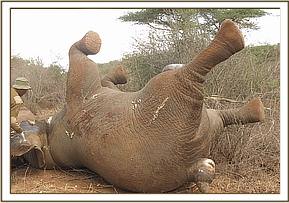
The elephant was recommended for disposal by burning to avoid contamination of the scene.
Samples collected
-Blood from the ear vein
-Blood smear
Tentative diagnosis
Poisoning
Acknowledgements
The Southern Conservation Area- Mobile Veterinary Unit is grateful to all individuals who played a role in assisting us towards achieving our goal. Many thanks to The David Sheldrick Wildlife Trust, The Samuel J and Ethel Lefrak charitable trust and The Kenya Wildlife Service for their continued support to this unit which aims at immediate response to clinical intervention, wildlife rescues and alleviating wildlife suffering.
